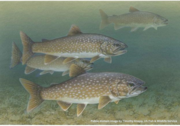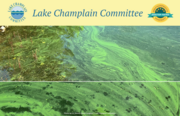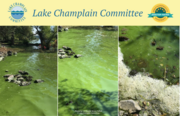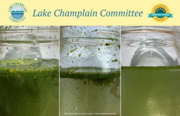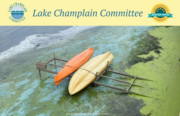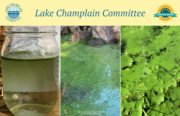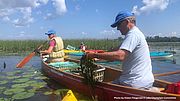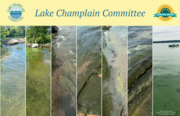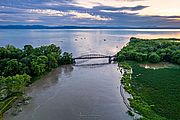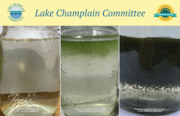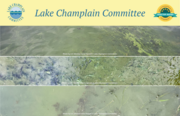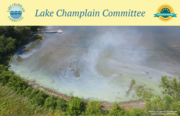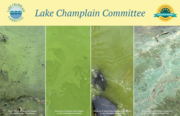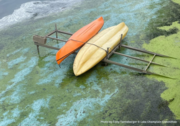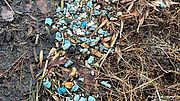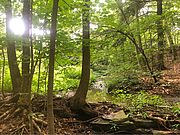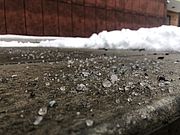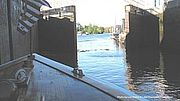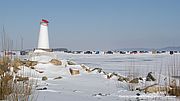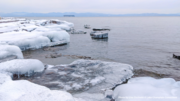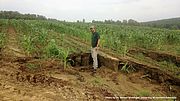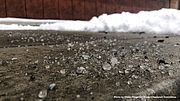For those who tend lawns, there are still a few more weeks until mowing season shifts to raking season. As such, there is time to make simple yet impactful changes to your lawn maintenance that will benefit soil health, water quality, and save you time.
If you have a grass lawn and want to keep it that way, there are management practices that you can adopt to reduce runoff and promote water quality. Consider Raising the Blade to at least three inches. This allows roots to grow deeper, as grass can divert energy to extending roots rather than re-growing the cut blades. Deeper roots aerate the soil and improves capacity for water retention. Raise the blade to a point where you’re removing less than 1/3 of the grass blade when mowing. This reduces stress to your lawn, which helps it stay green and lowers water demand. Leave the grass clippings where they fall after mowing—they will help fertilize the grass naturally as they decompose, foster a healthier lawn, and save you time! Read...
The story of lake trout in Lake Champlain is one of mystery and hope. In spring 2023, the Lake Champlain Fish and Wildlife Management Cooperative – a working group of fisheries professionals from the New York State Department of Environmental Conservation, the Vermont Fish and Wildlife Department, and U.S. Fish and Wildlife Service – announced plans to halve the annual stocking of lake trout in Lake Champlain this year. They cut back because of increases in lake trout wild recruitment, or survival past the first winter of life. This follows a trend of jumps in lake trout populations and subsequent reductions in stocking—there was a 30% reduction in trout stocking in 2022. While thousands of animal populations across taxa around the world plummet, the native lake trout of Lake Champlain are making a comeback. Why? Read...
We had fewer reports during week 12 in part due to a lower incidence of blooms but also because municipal and state parks are closing and seasonal staff and volunteers are leaving the region so there are fewer monitors reporting as summer ends. However, fall blooms are not uncommon so the monitoring program will continue through October with reduced site coverage. Lower temperatures will cool the water surface and generally reduce the incidence of blooms in deeper waters like Lake Champlain’s Main Lake, but shallow water areas like Missisquoi and St. Albans Bay and Lake Carmi will be less affected and blooms may continue. Read...
It was another challenging week for water quality with nearly half of the 188 reports received from Lake Champlain sites chronicling blooms during week 11. Hot temperatures over the Labor Day weekend spurred cyanobacteria growth and blooms were reported in every Lake Champlain lake segment except for the South Lake. Read...
During week 10 of cyanobacteria monitoring over a third of the 148 Lake Champlain reports received were of blooms. Blooms were dominant again in St. Albans Bay and Missisquoi Bay but also colored waters and shoreline areas in parts of the Inland Sea, Main Lake North, and Malletts Bay. Main Lake Central, Main Lake South, and the South Lake were bloom-free. Read...
Blooms continued to dominate Lake Champlain monitoring reports from St. Albans Bay and Malletts Bay during week 9 and were also recorded in Missisquoi Bay, the Inland Sea, Main Lake North, and Main Lake South. Main Lake Central and the South Lake were again bloom-free but we received very few reports from the latter lake segment. Read...
It was another week of bloom gloom at many northern Lake Champlain sites. The majority of reports from St. Albans Bay, Missisquoi Bay, the Inland Sea, St. Albans Bay, and Malletts Bay sites were of bloom conditions. Main Lake North also had a significant number of blooms while all site reports from Main Lake Central to the South Lake were bloom-free. Some monitors reported that they witnessed the worst conditions they had ever seen in a particular lake section. You’ll find specific details from Lake Champlain and VT Inland Lake sites in this report. Read...
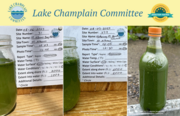
Another challenging week for St. Albans Bay with blooms dominating the reports for that section of Lake Champlain yet again. Blooms were also witnessed in Missisquoi Bay, the Inland Sea, and Main Lake North. Other sections of the big lake were bloom-free for week 7 as were the VT Inland Lakes based on the reports we received. While it is characteristic of recent trends that we see blooms concentrated in St. Albans Bay and Missisquoi Bay this time of year, be mindful that they can happen anywhere. The heavy nutrient loading from the July 2023 flooding as well as temperature and weather patterns all influence conditions. This email is a compilation of week 7 (8/6 – 8/12/23) monitoring results but three days into week 8 we have already received over 50 bloom reports from Lake Champlain sites in Missisquoi Bay, St. Albans Bay, the Inland Sea, and Malletts Bay! In some cases monitors have noted blooms extending as far out into the waters as they can see. Witnessing a cyanobacteria bloom can take an emotional toll – blooms threaten water quality, public health, recreation, the economy, and quality of life. We’re bearing witness to painful changes in our waterways. Monitoring is not the end result of the Lake Champlain Committee’s work, it’s foundational for our nutrient reduction advocacy. Read...
Blooms hit St. Albans Bay hard again with cyanobacteria persisting at some locations all week long or showing up off and on during the sixth week of monitoring. August and September are often prime times for bloom conditions so please use the resources and links in this email to learn how to recognize and report cyanobacteria. Read...
Take your gardening skills to the water! Join the Lake Champlain Committee (LCC) and the VT Department of Environmental Conservation for a hands-on activity to remove the invasive water chestnut from the shallow water areas around Sandbar Wildlife Management Area. Read...
Blooms took off during week 5 in many areas of Lake Champlain’s St. Albans Bay closing the town beach and impeding recreational use for most of the week. Blooms also showed up at several Burlington sites in Main Lake Central but didn’t persist for as long. August is historically when many locations are more susceptible to blooms and the recent heavy nutrient loading from the July 2023 floods may exacerbate this situation. Read...
The floods of July 2023 brought devastation to so many throughout the Lake Champlain Basin—they inundated homes and businesses, destroyed crops and livelihoods, and washed away roads. Rivers throughout the basin rushed to levels not seen in nearly 100 years, with staggeringly high flow ultimately pouring into Lake Champlain. What did the rivers carry, what does this mean for the lake, and how can we be more resilient in the future? Read...
It has been two weeks since flooding devastated many communities in the Lake Champlain watershed and throughout the state of Vermont. The heavy rains lasted for days and sent rivers and streams over their banks, pouring into homes and businesses and carrying a swill of debris, nutrients, sediment, untreated wastewater, chemicals, and more into Lake Champlain. Read...
There were fewer blooms during week four than during the first two weeks of monitoring but we are not in the heart of bloom season yet. We also likely saw a reprieve in some areas due to the turbidity and dilution factors from the flooding. However, we are bracing ourselves for the after-effects of all the additional nutrient loading which will help feed future blooms. Read...
Far fewer bloom reports were received during Week 3 of the cyanobacteria monitoring season. This is largely attributed to the volatile weather patterns and the increased turbidity from the flooding that affected much of Lake Champlain as well as Vermont inland waterways. The heavy sediment load carried by a high volume of water had a combined effect of limiting light necessary for bloom growth and diluting existing cyanobacteria. However, flooded tributaries also sent high levels of nutrients to Lake Champlain and other waterways. Early estimations are that some tributaries delivered more phosphorus to Lake Champlain during the July 2023 floods than during all of 2022! This will likely fuel blooms later in the season. Read...
Week 2 of cyanobacteria monitoring began with another spate of bloom reports and ended with catastrophic flooding which has devastated communities in the Lake Champlain watershed and throughout the state of Vermont. We hope you are safe, healthy, and dry—and that you’ve made it through the storms (which aren’t over) without damage. While Lake Champlain is below flood stage, it is receiving a heavy load of debris, nutrients, sediment, and a stormwater swill of oil and other pollutants from swollen tributaries, wastewater overflows, and failed septic systems. Read...
Lake Champlain has one particular quality that sets it apart from its Great Lake neighbors. The Lake Champlain Basin has the highest ratio of land to water; in other words, it has the greatest amount of land draining to the smallest area of water. That means that residents of the Lake Champlain Basin .have an opportunity to use land stewardship as a means of water protection. There are many approaches to managing land with water quality in mind depending on what kind of land you’re working with, but one surefire land management strategy for healthy waterways is a stream buffer. Read...
Cyanobacteria Monitoring began the week of June 25 and will run through early fall. Subscribers to our emails will receive weekly updates about conditions monitors are finding on Lake Champlain and at many inland lakes. This week’s report covers conditions from Sunday, June 25 through Saturday, July 1, 2023. If you’d like to learn more about cyanobacteria or join our monitoring team please sign up here. We will hold training sessions on Wednesday July 12 from 9:00 a.m. until Noon and 5:30 to 8:30 p.m. Read...
June 2023 - Summer breathes life into the Champlain Valley—trees leaf, insects hum, and birds come back to their summer homes. Among this annual reawakening of ecological activity is cyanobacteria. With longer and sunnier days warming the lake, conditions can become a breeding ground for blooms of cyanobacteria (sometimes called blue green algae, even though they are not technically algae) that can inundate water and close beaches. Read...
In March of 2023, the Lake Champlain Fish and Wildlife Management Cooperative – a working group of fisheries professionals from the New York State Department of Environmental Conservation, the Vermont Fish and Wildlife Department, and U.S. Fish and Wildlife Service – announced plans to halve the annual stocking of lake trout in Lake Champlain this year. It's a response to recent increases in wild recruitment, or survival past the first winter of life, of lake trout. While thousands of animal populations across taxa around the world plummet, the native lake trout of Lake Champlain are making a comeback. Why?
Read...
The Stone Age, the Bronze Age, and the Iron Age have come and gone, and some scientists say that we are now living in the Plastic Age. Major bans of single-use plastics, including many single-use EPS products, became law in Vermont in 2019 and New York in 2022. While the bans on single-use plastics including EPS foams were major steps in curbing plastic pollution, there is one type of EPS foam that doesn’t just end up in the lake, but is purposefully put in the lake by design: dock foam. Read...
Since the time of European settlement, Vermont has lost half of its wetlands in the Champlain Basin to development and agriculture, and more than a third of wetlands that existed statewide.1 Wetlands are known by a lot of different names – swamps, marshes, peatlands, sloughs, bogs, fens, and potholes, among others – and are a critical part of Vermont’s landscape. Read...
When road salt dissolves, it needs to go somewhere—and in the Lake Champlain Basin, it winds up making our lake a bit saltier, which is bad news for freshwater life. Read...
The $37.8 billion Water Resources Development Act (WRDA) of 2022 was passed overwhelmingly by the House and Senate and signed into law by President Biden in December. WRDA is biennial legislation that authorizes flood control, navigation, and ecosystem restoration projects for the U.S. Army Corps of Engineers (ACOE). With a $37.8 billion budget, the 2022 version is the largest WRDA in history. In addition to providing authorization for the ACOE to undertake water resources infrastructure projects to address flooding, water transportation, and ecosystem restoration, the bill includes provisions to support underserved communities and address climate change.
WRDA aims to strengthen water restoration, waterway resiliency, invasive species management, and emergency flood protection by channeling more funds and resources to the ACOE for risk management studies and new projects. Key provisions that will help Lake Champlain are outlined below. Read...
Though the days are just starting to lengthen in this new year, winter’s hold on Lake Champlain has really just begun. Lake Champlain does what all water does in cold enough temperatures—it freezes. When record keeping on Lake Champlain freezing began in the 19th century, it was rare for a winter to go by without a complete freeze-over from shore to shore of the lake. This regular freezing created the basis for a seasonal culture of ice-centered activities. Icy activities have been a part of life in the Lake Champlain basin for generations untold, but freezing frequency is expected to plummet due to climate change. Read...
Calling All Paddlers’ – We Want Your Pictures! LCC is seeking boating pictures to enhance our 2023 edition of the Paddlers’ Trail guidebook. If you ventured out on the water with a camera in the past year or two, please consider sharing some photos with us. We are looking for images of human-powered adventures on Lake Champlain and any discoveries made along the way. Scenes of paddling with friends (all wearing PFDs of course), packing your gear, fishing from your boat, taking in a sunrise or sunset, and other visual reflections of water outings are welcome. Read...
While Lake Champlain is not as cold or icy this winter as it has been in winters of yore, it is still not a place for a casual swim at this time of year. This inaccessibility gives the depths of the lake a certain mystery. What is going on underneath the dark surface of Lake Champlain as winter unfolds? How do fish hunker down and survive what seems to be a hostile environment of icy cold water all season long?
Read...
LCC and partners of the Champlain Basin Education Initiative (CBEI), a community of organizations engaged in watershed education, will host Watershed for Every Classroom (WEC), a year-long professional development program for interdisciplinary teams of K-12 teachers in the Lake Champlain Basin.
WEC is like camp for teachers! Participants travel the Basin, visit farms, paddle waterways, explore mountain tops, tour urban areas, and much more! The program helps educators enrich their curricula with local, relevant and engaging topics while addressing national standards and district expectations. Participants network with teachers from around the Basin in Québec, New York and Vermont and meet with Basin scientists, historians, and stewards who work in watershed protection. Read...
Changes in precipitation patterns from climate change is fueling cyanobacteria blooms on multiple fronts. Learn about how soil management can help. Read...
After a warm start to the season, it is finally starting to look--and certainly feel--like winter in the Lake Champlain Basin. To make walking and driving safer in this icy season, state and municipal road crews salt roadways. This practice started in the 1930s, when cars became more commonplace and roads needed winter maintenance. Since then, the annual use of road salts in the US has increased—in the past 45 years, the amount has tripled—to a yearly estimated total of 25 million metric tons.
All of this salt has to go somewhere. When in contact with the water, salt dissolves into its ion building blocks, the most common of which are sodium and chloride. The now salty water first washes off roads, stoops, parking lots, and sidewalks, and it can kill adjacent vegetation quickly, as these species are rarely adapted to high salinity. Salty water then either seeps into groundwater or flows through waterways, winding up in larger reservoirs like Lake Champlain. Chloride concentrations in Lake Champlain and its tributaries have been steadily rising for the past several decades. Read...


